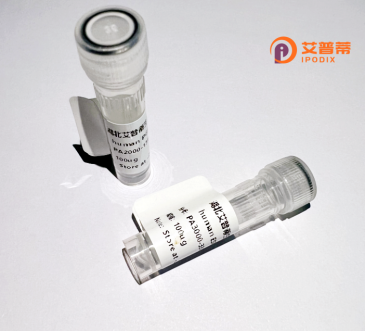
| 纯度 | >90%SDS-PAGE. |
| 种属 | Human |
| 靶点 | KIAA1609 |
| Uniprot No | Q6P9B6 |
| 内毒素 | < 0.01EU/μg |
| 表达宿主 | E.coli |
| 表达区间 | 1-456aa |
| 活性数据 | MGNSRSRVGRSFCSQFLPEEQAEIDQLFDALSSDKNSPNVSSKSFSLKALQNHVGEALPPEMVTRLYDGMRRVDLTGKAKGPSENVSQEQFTASMSHLLKGNSEEKSLMIMKMISATEGPVKAREVQKFTEDLVGSVVHVLSHRQELRGWTGKEAPGPNPRVQVLAAQLLSDMKLQDGKRLLGPQWLDYDCDRAVIEDWVFRVPHVAIFLSVVICKGFLVLCSSLDLTTLVPERQVDQGRGFESILDVLSVMYINAQLPREQRHRWRLLFSSELHGHSFSQLCGHITHRGPCVAVLEDHDKHVFGGFASCSWEVKPQFQGDNRCFLFSICPSMAVYTHTGYNDHYMYLNHGQQTIPNGLGMGGQHNYFGLWVDVDFGKGHSRAKPTCTTYNSPQLSAQENFQFDKMEVWAVGDPSEEQLAKGNKSILDADPEAQALLEISGHSRHSEGLREVPDDE |
| 分子量 | 77.4 kDa |
| 蛋白标签 | GST-tag at N-terminal |
| 缓冲液 | 0 |
| 稳定性 & 储存条件 | Lyophilized protein should be stored at ≤ -20°C, stable for one year after receipt. Reconstituted protein solution can be stored at 2-8°C for 2-7 days. Aliquots of reconstituted samples are stable at ≤ -20°C for 3 months. |
| 复溶 | Always centrifuge tubes before opening.Do not mix by vortex or pipetting. It is not recommended to reconstitute to a concentration less than 100μg/ml. Dissolve the lyophilized protein in distilled water. Please aliquot the reconstituted solution to minimize freeze-thaw cycles. |
以下是关于重组人KIAA1609蛋白(CEP170)的3篇参考文献,涵盖其功能、结构及调控机制:
---
1. **文献名称**:*CEP170 interacts with the centriolar satellite components PCM-1 and Ninein*
**作者**:Gräser, S., et al. (2007)
**摘要**:研究发现KIAA1609/CEP170通过重组蛋白实验证明其与中心体卫星蛋白PCM-1和Ninein的互作,参与调控微管锚定及细胞分裂过程中中心体的结构完整性。
---
2. **文献名称**:*CEP170 coordinates ciliary membrane and microtubule dynamics*
**作者**:Gupta, G.D., et al. (2015)
**摘要**:利用重组人CEP170蛋白验证其结合微管和膜泡的能力,揭示其通过N端结构域调控纤毛形成中膜与细胞骨架的动态平衡,影响细胞信号传导。
---
3. **文献名称**:*Molecular basis for CPAP–CEP170 interaction in centriole duplication*
**作者**:Bärenz, F., et al. (2013)
**摘要**:通过重组CEP170蛋白的截断体实验,证明其与CPAP蛋白的互作依赖C端结构域,调控中心体复制和纺锤体组装,影响细胞周期进程。
---
**备注**:若需扩展文献范围,可进一步筛选涉及重组表达、纯化或药物筛选的研究(如基于KIAA1609结构的抑制剂开发)。
The recombinant human KIAA1609 protein is a large, multidomain protein encoded by the KIAA1609 gene, initially identified through large-scale cDNA sequencing projects. Predominantly expressed in neural tissues, KIAA1609 is implicated in cytoskeletal organization, neuronal development, and intracellular trafficking. Structurally, it contains coiled-coil domains and a conserved DENN (differentially expressed in neoplastic versus normal cells) module, suggesting roles in membrane trafficking or GTPase signaling regulation. Studies link KIAA1609 to primary cilia function, potentially influencing ciliopathy-related pathways and neurodevelopmental disorders.
Recombinant production typically employs eukaryotic systems (e.g., HEK293 cells) to ensure proper post-translational modifications. Purification methods often involve affinity chromatography followed by tag removal and validation via SDS-PAGE/Western blot. This engineered protein enables functional studies exploring its interactions with microtubule-associated proteins, Rab GTPases, and ciliary components. Researchers utilize it to investigate cellular mechanisms underlying intellectual disabilities, Joubert syndrome, and other ciliopathies. Its recombinant form has become crucial for structural analyses, antibody development, and high-throughput screening for therapeutic targets, bridging gaps in understanding neurodevelopmental biology and disease pathophysiology.
×